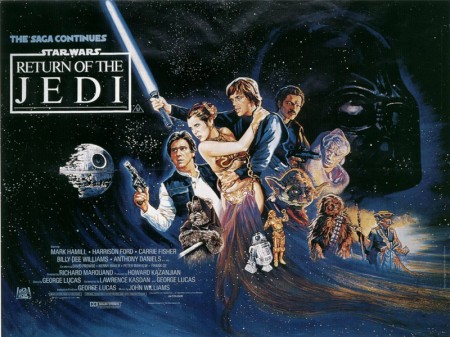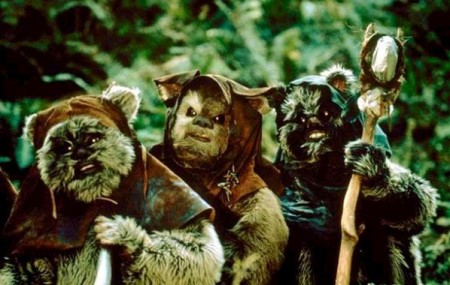Strange Moments in Solid Movies: Return of the Jedi Buzzkill
Call me crazy, but I subscribe to the notion that, since its beginning, the universe has been ever-spreading and everything within its massive expansion has gone along for the ride. Following suit, every initial notion with storytelling potential tends to enlarge exponentially, growing with time and purpose into stories and, if the commercial and/or artistic drive remains resolute, these stories multiply into sequels and beyond. This especially holds true for the interstellar saga from a long time ago in a galaxy far, far away. After its explosive entrance into the public sphere in ‘77, the Star Wars universe took three years to develop from A New Hope into The Empire Strikes Back, wherein its archetypal characters became more complex and their dilemmas darkened as SW’s expansion followed its primary course into the emptiness of space. But then something changed: George Lucas, supreme author, came down and let there be lightness where the darkness once dominated. And this certifiable change is evident in the trilogy’s finale, Return of the Jedi.
In truth, RotJ is a solid capper to the series; its problematic reputation stems from the fact that the duo that preceded it is sensational, tracking a fantastic rising action even as it descended into shadowy places. ANH and ESB is an incredible one-two punch in the dicey bout against the mythical movie-monster known as Great Trilogy. And even though RotJ gets a little apprehensive about what the children in the audience will think about seeing it engaged in such fierce action (a story that was originally called Revenge of the Jedi before Lucas deemed revenge unbecoming to the Jedi), it lands enough genuine blows to make it a more than respectable contest. Still, what started out as a masterpiece of narrative plotting gets tripped up in spots on its way to a successful decision–no doubt spurred on by its early successes.
But enough with this borderline mixed-metaphorical write-up; let’s talk about the real issue at hand: RotJ’s mixed-up tone. Previously in this column, I wrote about how Butch Cassidy and the Sundance Kid is tonally dynamic, veering wherever it pleases, and how that’s ultimately a reason for its greatness. An important distinction between these two films is quite obvious: Butch Cassidy is a stand-alone movie, while RotJ is a continuation of a larger narrative. So keeping some semblance of tonal consistency would probably be beneficial to the whole work since it is, for the most part, one complete arc. And Lucas’ infusion of kiddie-loving hijinks and a newly developed penchant for edification is oftentimes at odds with the dark and dangerous trajectory already set into motion by the previous movies.
Throughout RotJ, there is a push-and-pull tension, originating from an apparent need to both lighten the mood and reveal heavy consequences in equal measure, as if Lucas wished for the finale to be huggable and teachable simultaneously. (Only mention of prequels: they went to preposterous lengths to make most villains droids and clones to lessen the gravity of lethal actions taken by the protagonists against them, so deaths are not nearly as severe as they had been in the prior films). Because of this, RotJ has several strange moments that vary between the somber and cheerful, fun and deathly serious. So, not only are the Ewoks fun-loving and played up as comic relief, but we also see them in action during the final battle, one that is spirited and relatively danger-free for the good guys until it’s not so much. The cutesy creatures can meet real ends because ANH and ESB set the scene for such menace and, in order not to be overwhelmingly jarring (just plain old jarring), there has to be some tonal follow-through.
Similarly, Mon Mothma’s somewhat standard explanation of the attack plans on the new Death Star is undercut by the knowledge that many Bothans died to bring them this vital information, an inclusion that essentially comes out out of nowhere and then is mentioned no more. It ends up being a bizarre beat because the audience has no idea who the Bothans are nor do their deaths contribute to any real dread once the curiously prosperous Ewoks overtake the Empire with sticks, rocks, ropes, and any other clever amalgamation that can be made from these three destroyers of high technology. Viewed in conjunction with the Ewok’s battle prowess, the bittersweet success of the Bothans, though essential, raises doubts about how cunning they are as rebel spies.
RotJ‘s inconsistency contributes to some true buzzkilling moments, when grimness detracts from the film’s attempted lightheartedness and vice versa. But, in typically puzzling fashion, the strangest moment in RotJ is also one of its most exhilarating: Luke’s fight with the rancor at Jabba the Hutt’s palace, a creature with one really big, emotional fan. Take a look:
Luke Skywalker, without using the Force or his lightsaber, is able to defeat the rancor, a gargantuan monster whose seemingly sole purpose in Jabba’s Palace is to consume pesky guests; anyone who gets in Jabba’s way–or, like the Gamorrean guard, anyone who cannot get out of the way–could be readily sent down to a terrible death. Thus, Jabba’s domain is inherently dangerous, inhumane, a place where its denizens don’t care for one others–a custom to which the Gamorrean guard could probably attest right before he is eaten alive as his associates cheer. However, despite the depravity and the relentlessly hostile mood of the environment, and even after Luke has used his wits and agility to defeat the beast, the audience is not allowed to enjoy it completely. What should be diverting becomes anything but because one man is distraught by the rancor’s defeat. The crying man adds a bizarre dimension to the scene, which suggests that we too should feel something besides excitement after seeing our hero survive a treacherous ordeal, that what just happened is not completely entertaining.
This moment may expand Jabba’s Palace a little bit (showing that there can be a some compassion and sincerity in even the most corrupt places), but for the most part it’s a baffling addition. Every other inhabitant is bummed out by Luke’s victory, but the crying man takes it to another level. Did he raise the rancor or something? Or did he just take particular pleasure in seeing it kill others and, when it comes to be its turn to die, that pleasure becomes pain? It suggests there could be some redeeming quality to the rancor, a lighter or more personal side, but exactly what is unclear. Certainly, there is a pervasive notion of redemption in the movie as a whole (from the return of the Jedi in Luke’s ascendency as well as Darth Vader’s return to the light side at the end), but it is bestowed on a one-dimensional monster and fat guy for no real end other than to show that there could have been something more to the rancor. But extra characteristics/motivations aren’t needed for the monster and man; the only fleshing out that is vital to the story is one eats others’ flesh and the other likes to show off his own. Providing insight into what lies in the deepest recesses of their hearts is trivial.
Now, perhaps it is unfair to say the inconsistent tone of RotJ is completely Lucas’ doing. After all, he was the mastermind behind ANH and he certainly had an influential hand in ESB‘s excellence, so giving him some credit for them is appropriate, but his post-ESB fingerprints–ones that have stretched out over many other incongruous movies for the last thirty years, amounting to undeniable evidence of a man losing touch–indeed appear to be all over the SW finale. And even if he is not the main cause behind the strange moments in this solid movie, they nevertheless exist in a movie that certainly could have done well enough without them.





